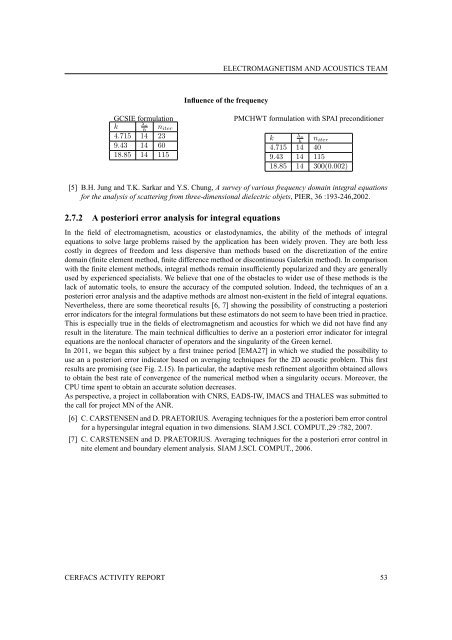CERFACS CERFACS Scientific Activity Report Jan. 2010 â Dec. 2011
CERFACS CERFACS Scientific Activity Report Jan. 2010 â Dec. 2011
CERFACS CERFACS Scientific Activity Report Jan. 2010 â Dec. 2011
Create successful ePaper yourself
Turn your PDF publications into a flip-book with our unique Google optimized e-Paper software.
ELECTROMAGNETISM AND ACOUSTICS TEAM<br />
Influence of the frequency<br />
GCSIE formulation<br />
λ<br />
k<br />
o<br />
h<br />
n iter<br />
4.715 14 23<br />
9.43 14 60<br />
18.85 14 115<br />
PMCHWT formulation with SPAI preconditioner<br />
λ o<br />
k h<br />
n iter<br />
4.715 14 40<br />
9.43 14 115<br />
18.85 14 300(0.002)<br />
[5] B.H. Jung and T.K. Sarkar and Y.S. Chung, A survey of various frequency domain integral equations<br />
for the analysis of scattering from three-dimensional dielectric objets, PIER, 36 :193-246,2002.<br />
2.7.2 A posteriori error analysis for integral equations<br />
In the field of electromagnetism, acoustics or elastodynamics, the ability of the methods of integral<br />
equations to solve large problems raised by the application has been widely proven. They are both less<br />
costly in degrees of freedom and less dispersive than methods based on the discretization of the entire<br />
domain (finite element method, finite difference method or discontinuous Galerkin method). In comparison<br />
with the finite element methods, integral methods remain insufficiently popularized and they are generally<br />
used by experienced specialists. We believe that one of the obstacles to wider use of these methods is the<br />
lack of automatic tools, to ensure the accuracy of the computed solution. Indeed, the techniques of an a<br />
posteriori error analysis and the adaptive methods are almost non-existent in the field of integral equations.<br />
Nevertheless, there are some theoretical results [6, 7] showing the possibility of constructing a posteriori<br />
error indicators for the integral formulations but these estimators do not seem to have been tried in practice.<br />
This is especially true in the fields of electromagnetism and acoustics for which we did not have find any<br />
result in the literature. The main technical difficulties to derive an a posteriori error indicator for integral<br />
equations are the nonlocal character of operators and the singularity of the Green kernel.<br />
In <strong>2011</strong>, we began this subject by a first trainee period [EMA27] in which we studied the possibility to<br />
use an a posteriori error indicator based on averaging techniques for the 2D acoustic problem. This first<br />
results are promising (see Fig. 2.15). In particular, the adaptive mesh refinement algorithm obtained allows<br />
to obtain the best rate of convergence of the numerical method when a singularity occurs. Moreover, the<br />
CPU time spent to obtain an accurate solution decreases.<br />
As perspective, a project in collaboration with CNRS, EADS-IW, IMACS and THALES was submitted to<br />
the call for project MN of the ANR.<br />
[6] C. CARSTENSEN and D. PRAETORIUS. Averaging techniques for the a posteriori bem error control<br />
for a hypersingular integral equation in two dimensions. SIAM J.SCI. COMPUT.,29 :782, 2007.<br />
[7] C. CARSTENSEN and D. PRAETORIUS. Averaging techniques for the a posteriori error control in<br />
nite element and boundary element analysis. SIAM J.SCI. COMPUT., 2006.<br />
<strong>CERFACS</strong> ACTIVITY REPORT 53
















